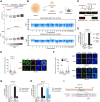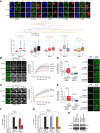DNA damage remodels the MITF interactome to increase melanoma genomic instability
- PMID: 38316520
- PMCID: PMC10903946
- DOI: 10.1101/gad.350740.123
DNA damage remodels the MITF interactome to increase melanoma genomic instability
Abstract
Since genome instability can drive cancer initiation and progression, cells have evolved highly effective and ubiquitous DNA damage response (DDR) programs. However, some cells (for example, in skin) are normally exposed to high levels of DNA-damaging agents. Whether such high-risk cells possess lineage-specific mechanisms that tailor DNA repair to the tissue remains largely unknown. Using melanoma as a model, we show here that the microphthalmia-associated transcription factor MITF, a lineage addition oncogene that coordinates many aspects of melanocyte and melanoma biology, plays a nontranscriptional role in shaping the DDR. On exposure to DNA-damaging agents, MITF is phosphorylated at S325, and its interactome is dramatically remodeled; most transcription cofactors dissociate, and instead MITF interacts with the MRE11-RAD50-NBS1 (MRN) complex. Consequently, cells with high MITF levels accumulate stalled replication forks and display defects in homologous recombination-mediated repair associated with impaired MRN recruitment to DNA damage. In agreement with this, high MITF levels are associated with increased single-nucleotide and copy number variant burdens in melanoma. Significantly, the SUMOylation-defective MITF-E318K melanoma predisposition mutation recapitulates the effects of DNA-PKcs-phosphorylated MITF. Our data suggest that a nontranscriptional function of a lineage-restricted transcription factor contributes to a tissue-specialized modulation of the DDR that can impact cancer initiation.
Keywords: DNA damage repair; DNA replication; E318K; MITF; NBS1; SUMOylation; homologous recombination; melanoma; replication stress.
© 2024 Binet et al.; Published by Cold Spring Harbor Laboratory Press.
Figures







References
Publication types
MeSH terms
Substances
Grants and funding
LinkOut - more resources
Full Text Sources
Medical
Molecular Biology Databases
Research Materials
Miscellaneous
